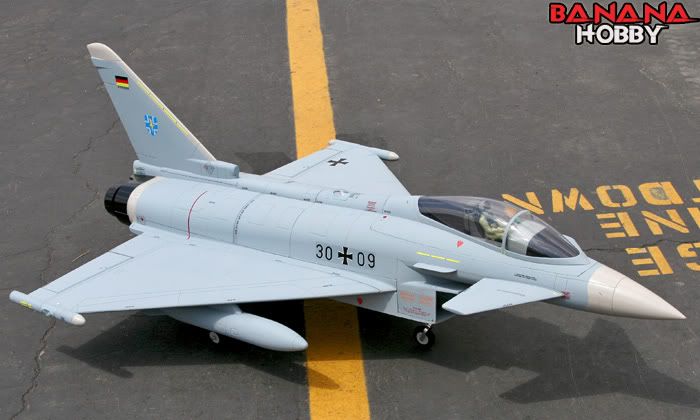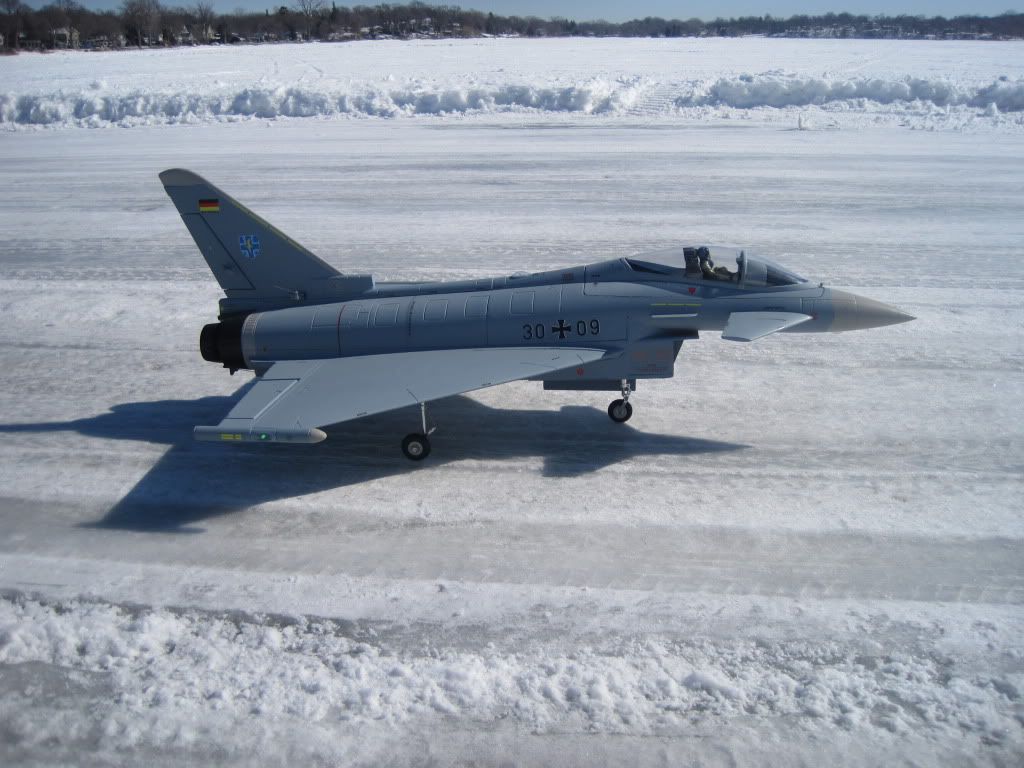19000rpm
Moderator    FIRST 30 MEMBER
FIRST 30 MEMBER
Posts: 5,183
|
Post by 19000rpm on Nov 22, 2012 13:24:42 GMT -6
 The Eurofighter 2000, for those who don't know the history, is Europe's premier defense and attack weapon. It has been for a number of years. As we move into the era of the F35 Joint Strike Fighter, with all of its purported capabilities, European defense departments are fighting to keep the Eurofighter. They love it all that much. And what with all of the F35 delays; they are more than justified in hanging on to the extremely capable and reliable Eurofighter 2000. It's also not surprising that Freewing's 90mm Eurofighter is very popular with modelers. It's faithful in its detail and the performance is said to be among the best, if not the very best, in the VT EDF category. I've been watching the pricing on this plane for a couple of years as I've be working my way up the EDF scale. It's usually in the $300 range plus shipping PNP. Last week BH put it on sale for $229 including shipping. It was time to pull the trigger. UPS is scheduled to drop her off Thurs. Nov. 28th. I'll let my wife wrap it for Christmas after I check it out. Then I'll put it away for a couple of months, during the dead of winter, before I start getting ready for spring flying. That seems like a long time away right now. Patience, patience  |
|
19000rpm
Moderator    FIRST 30 MEMBER
FIRST 30 MEMBER
Posts: 5,183
|
Post by 19000rpm on Mar 1, 2013 18:02:06 GMT -6
I put the Eurofighter together. The parts were all complete as advertised. The foam was well molded and painted in matte with German markings.
The assembly was straightforward with no surprises. Not much to it. Epoxy on mating surfaces, fishing some wires and installing the 7ch Rx. This time out I'm using an Orange 7ch with a satelite Rx. from HK.
The only electronics changes were adding a 10A Castle SBEC and switching out the T connectors (not sure they were real Deans) for EC5's since the EC5's will carry more current than the T types. There have been reports of melting T connectors by Euro owners.
I took the time to balance the fan. That never hurts and often helps to get the best performance and an improved sound from the motor. I used strips of aluminum tape on the inside of the rotor hub with a prop balancer to get it just right.
I added a functional flying rudder. The Euro comes with TV rudder only and I've found that set up on other EDF's to be somewhat lacking in gusting crosswinds at low speeds. I installed a servo at the base of the rudder and ran the wiring under the spine on the fuse (comes right off to expose the wiring for the wing servos and lighting) and Y'd the rudder to the nose steering.
The programming of my DX7 followed those in the instructions fairly closely but there was a reversal in the values required in the mix to get the flying canards to work properly. The canards work as additional pitch surfaces in the pitch axis and roll in the roll axis. My set-up has TV in the on mode all of the time for pitch, on dual rates, and on an Aux 2 on/off switch in the roll axis.
Bench testing produced 1570 Watts drawing 69.9 Amps. Right in the ballpark according to other Euro owners running the stock set-up that utilizes a 1750kV outrunner and an 85A ESC.
I thought I was going to have to wait for spring to fly, but some nice guy plowed an ice road on the bay by my house. First time out I used a GForce 4000mAh 6s for juice. After control and range test, set the controls to low rates, checked for clearance on the road in both directions and let her rip.
The sky was bright blue. The horizon far in the distance. Wind was light and on the nose. Steering was a bit off to the right and was easily corrected at the Tx. I had more than ample taxi and roll out room so I felt no rush to make rotation. I let it get up to speed and then gently moved the stick back. Rotation was smooth lifting into a 30 degree climb. The sight of the big delta wing in the climb out was enough to make my breath catch.
Once I had some altitude I cut the throttle to 3/4 and took my hand off the sticks. She tracked straight in the roll and yaw axis and was slightly nose up. I corrected with a few clicks of down elevator. The nose up attitude is a function of the canards needing just a bit of nose down mechanical or computer trim.
Still on low rates, with no TV in the roll axis, I did a roll. Very nice. Looked very much like what I have observed of the full size in vids. Next, a nice little loop. Then I gave it full throttle and put it on deck for a fly-by. Awesome. In the mid 80's. About that time I had traffic coming from both directions on the ice road. They stopped in their tracks when they saw the Euro screaming down the road at 6ft altitude. A vertical spinning climb finished the acrobatics for the flight.
One flyby to check the gears in the down position and then I lined up the final in that classic slightly nose up attitude with reduced throttle until it settled on the ice. Beautiful with no drama. What a great plane. I can't wait to do it again.
|
|
|
|
Post by akphill on Mar 2, 2013 12:09:55 GMT -6
Sounds like a good plane
Now where is the maiden video lol
|
|
19000rpm
Moderator    FIRST 30 MEMBER
FIRST 30 MEMBER
Posts: 5,183
|
Post by 19000rpm on Mar 2, 2013 15:07:07 GMT -6
No video, but here are a few still shots out on the ice road just before the 2-4 flights today. Gathered another crowd.  |
|
|
|
Post by akphill on Mar 2, 2013 18:22:11 GMT -6
That is a sharp looking plane sitting there next to the car
really looks good glad it fly's perfect for you
|
|
19000rpm
Moderator    FIRST 30 MEMBER
FIRST 30 MEMBER
Posts: 5,183
|
Post by 19000rpm on Sept 2, 2013 15:59:44 GMT -6
I'd put 40 flights on the Euro and on flight 41 I lost orientation when turning on to final. It was weird. The light was changing bright to dim through fast moving clouds and all of a sudden I lost it. Next thing I saw it was vertical, then stalled and dropped below the tree line. Crunched her up pretty bad but was lucky the edf, wings, electronics, battery, most of the servos and vertical stab survived. This was the first time I'd lost orientation in quite a few years. It was a wake up call to the fact that even a large plane with a distinctive shape, well within normal visual range, can be subject to being difficult, or impossible, to see if the conditions conspire to make it so. That's the thing about this hobby: You never stop learning.
I ordered up a new fuse (The fuse comes complete with wiring, lighting system and nose gear door servo and sequencer and misc. hardware) canards, cockpit, decals and nose cone. I was surprised at the difficulty I had rounding up the parts and ended up getting them all, after a bit of a wait for restocking, from Motion RC a relatively new veteran owned dealer in the Midwest. Good people.
So, now I'm in the middle of the rebuild. It won't take long. Most of the work is simple.
There is something different I get out of a rebuild that I don't from putting a new plane together: The realization of how special any one these planes can become, even though only slabs of foam or sheets of wood and film, almost like making a friend over time, a bond that builds with each and every tweak, maintenance and hangar rash repair, thrill of a new maneuver learned and satisfaction that comes with each successive flight.
|
|